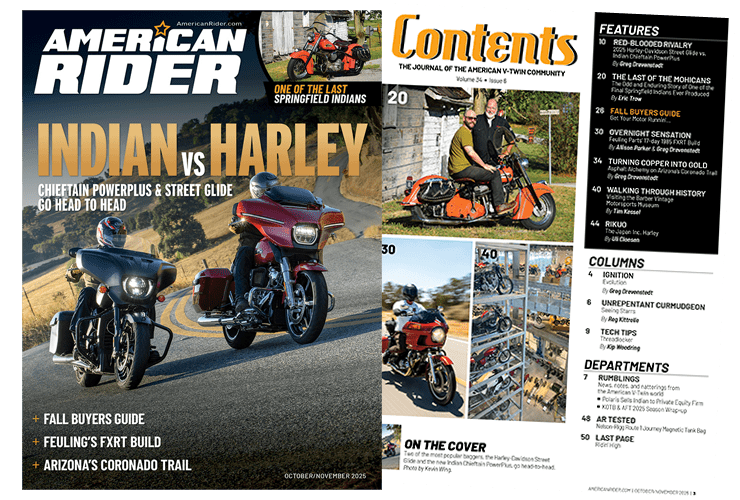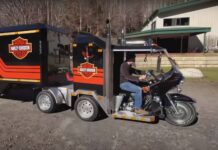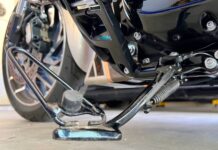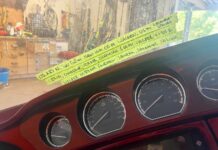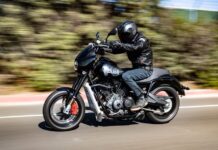
Excluding the M-8 (until time tells)… all-alloy OHV Harley engines exhibit traces of three legacy “foibles.”
1. Noise coming from the rocker boxes.
2. Oil leaking from the rocker boxes
3. Poor control of the air and oil within that results from positive and negative “pulses” in the rocker boxes, a.k.a. “oil carryover!”
It could be argued that Sportsters from 1991–2003 are representative of all three rocker box issues… maybe the most representative. Most Sportster owners (and you know who you are) with bikes from this era have some top-end noises or a leaky bottom box gasket or a little lubricant misting out of the air cleaner. If you don’t… you will. Human nature dictates that most of us will wait until things get ugly before taking action. Fair enough! But, when the day dawns that you need to deal with any one of them, why not take care of all three? (I mean—as long as you’re in there, anyway!) My friend Paul has a Sportster Sport 1200S with a mere 700 miles from new. Paul isn’t much good at living with niggles that can be helped significantly and yours truly is pretty big on passing that info on, so we decided to address all three issues at once.
Whether you DIY or hire it done, here are parts you’ll need for ’91–’03 XLs:
• Two H-D #1039 screws (or equivalent)
• One front (#26012-07) and one rear (#26020-07) rocker box breather for ’07–on Sportster
• Two lower rocker boxes for ’07–on Sportster (part numbers vary according to finish)
• Two lower rocker box gaskets (#17362-07A)
• Two “chimney” gaskets (#17695-07A)
• Cometic box-to-head gaskets (#RB020 pr.) or equivalent
• Rocker Lockers kit (#DK-RL-SPT-8606)
• Two middle rocker box gaskets (#17354-86A) or sharp scissors and new (#17354-89)
• Lastly… and tricky… is two middle boxes (“D-rings”). You’ll either have find some (obsolete ’86–’89 style) #17355-86B on eBay, at a swap meet, wherever—or be ready to modify the ones you have.
DIY-ers will also need tools and a manual… and perhaps to study the innumerable videos on YouTube that walk you through the actual process. From here on we only hit the highlights in this little essay.
1. Lid off, rocker shaft bolts out and you should see something like this:
2. You’re likely to see something like this as well. The “fish lip” crescents towards the head of the rocker shaft bolt are witness marks, left by the back-and-forth rotation of the rocker shaft as the engine runs. Yup… noisy! Moreover, this chattering movement doesn’t really speak well for the long-term health of the shaft itself. (Remember, this engine only has 700 “clean oil” miles on it and is immaculately maintained.) The spiral mark is actually from the removal of the bolt. It would be great if this doesn’t happen when you remove yours, but some will and some won’t… so don’t be surprised either way. If there’s no other damage, don’t worry about replacing them with new ones.

3. As we continue disassembly, inspection of the shaft on this low-miler also tells a tale… although not the one you might think at first.
The striations and scuff marks where the rocker bushing runs usually indicate that grit in the oil has turned the bushing into a grinder. Ironically, most of the time the bushing will look and spec “as new,” yet the shaft will not. That’s because the grit can bury itself in the softer bronze material of the bushing and “sand down” the harder shaft. By contrast, the area of the shaft held by the bolt we just looked at is in fine shape even though we know it’s rocking back and forth a bit. Might that mean the shaft is harder than the alloy in the rocker box it rocks in, and therefore doing a tiny bit of sanding on the shaft bore in the box? No matter! If your shaft(s) won’t pass a fingernail test for smoothness, you might want to replace it/them. But most of the time it’s just as effective to simply swap them back to front, top to bottom when replacing. That gives the bushing a new, untouched surface to rub on.
4. Once the box is off, you’ll need to scrape any clinging old gasket material off. It’s important to do it carefully, with the tool of your choice (razor blade or whatever) in order to leave a clean, smooth, unmarred surface for the new replacement.

5. In the case of this head, the replacement is a “metal sandwich” Cometic gasket, like these. There are options here, including latest OEM, but the original type isn’t one of them. Gasket/sealing technology has come a long way in the last few years. So using the latest gasket design from a quality supplier goes a long… long… way towards a cure for leaks from this area!

6. OK, the bench work starts! The ’07–on rocker box on the left is the one to use. There are plenty of subtle differences, but the ones to note are: the bosses where self-tapping #1039 screws (one is in place at the top of the pic) can be used to hold down new style breathers, the shape of the hole the breather rests in, and the narrower gasket/rubber grooves.
7. Speaking of rocker box seals… here they are. Since the Sportster we’re upgrading is equipped with three-piece boxes, a mix of old and new styles is essential to the intended end result. Like the Cometic base gaskets, these thinner “stand up” rubbers work best to eliminate leaks.
8. Next, you’ll need these—an excellent aftermarket solution to noisy valve gear, courtesy of Rocker Lockers. It amounts to four tapered brass sleeves that are installed in the rocker shaft and hold down bolt holes. (In fairness, this idea originated with a company called “Rock Out,” but as of this writing, they do not offer a kit specifically for Sportsters… only Twin Cams.) As you see, the Rocker Lockers kit comes with some extra bits: a nut and bolt to use for installation and, notably, a white plastic device used to align the shaft cut outs prior to insertion of the sleeves. The instructions spell it out, so no problems getting it right quite easily.
9. Once the rocker shaft is inserted in the position intended for its future use (see #3) and aligned with the plastic device, the kit’s nut and bolt are used as seen here to gently slide the Rocker Locker sleeves into position. You might find that in some instances they will almost slide in with finger pressure and, in others, a little WD-40, more force and some patience will be required—but they will fit perfectly once installed properly. As for what’s “proper” (if the only part of this project you do is Rocker Lockers), don’t be tempted to simply insert the sleeve and run it down with the original fastener with the rocker box in place! A very bad plan that only seems like a good idea.
10. Done right it looks like this…
11. …and is designed to take up the slack in the factory arrangement… like this! A simple, brilliant solution to an annoyance resulting from the realities of mass production. A way to sort of “blueprint” your rocker shaft mounting, for lack of a better way to say it. Less wear, less noise, all good!
12. Next up, and perhaps the best upgrade of the bunch, is the installation of the newest factory breather design. A vast improvement over ineffective “umbrella” valves! This black one is for the front cylinder. The rear breather is a sort of tan/beige color… coded so as not to mix them up… they only really fit one way. And they do not fit earlier lower boxes (see #6)! Don’t forget the red seal!
13. Now, before any reassembly comes the only mod required. The center “D-ring” must have the area that held the original umbrella valve cut out! Use a hacksaw, power saw, grinder, a file, any or all of the above… your choice. What you don’t have a choice about is retaining the inside “lip” in this area of the box. That lip holds the box sealing rubber in place so don’t let it disappear! (Or, try to find a couple of good center D-Rings from an ’86–’90 four-speed Evo XL… they don’t have ’em, so you won’t need to cut ’em.) 
14. Snip the section of the rubber D-ring gasket to match the cut in the D-ring, and your mods are complete. Assemble the lower box completely and… 
15. …place the Cometic (or equivalent) gasket on the head. Then install the lower rocker box. Yeah… this can be fiddly since you don’t want to “stick” this type gasket in place with anything. Do it dry and take your time. (An extra set of hands can be a good thing for this task.)
16. Oops! Probably should have mentioned this earlier! Just in case you haven’t already, now is the time to inspect the tips of the pushrods and both of the working ends of the rocker arms. Nothing to report on a 700-mile Sporty, but any bike with tons of miles on it deserves a close look at all contact points, and replacement if wear is as bad as the dorked-up tip shown here.
17. OK… lower box in place… all three upgrades (big breathers, Rocker Lockers and metal rocker base gaskets) on board. (By the way—the hexagon doohickey you see is a tappet block alignment tool, handy for centering rocker boxes too.) Once centered, however centered, it remains to bolt it down… by the book (or video).
18. Fit the modded D-ring with the new-style rubbers and make damn sure the new style breather doesn’t interfere with bolting it back on the lower box… square and centered! Once this is accomplished all that remains is to bolt the lid back on, put the rest of the bike back together and take a test ride. Quiet valve gear, no leaks and a hell of a lot less likelihood of oil carryover into the air cleaner—not a bad return on your investment.
19. P.S. Finally, let the record show, the factory has engineered the M-8 Big Twins to eliminate all three of the legacy rocker box issues. The sandwich lower gaskets will seal, the breathing now vents to the voluminous tranny case (with no path to an air cleaner at all)… and… take a look! Yeah, the M-8 rocker shafts are bolted down solid! Yay!


